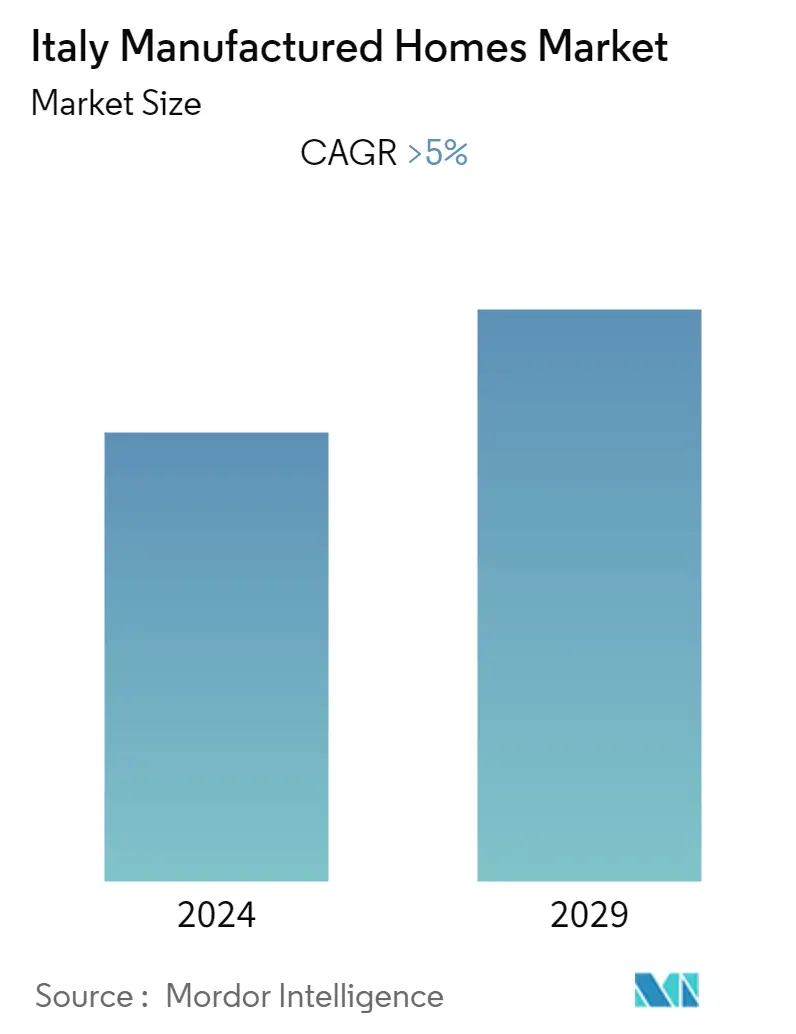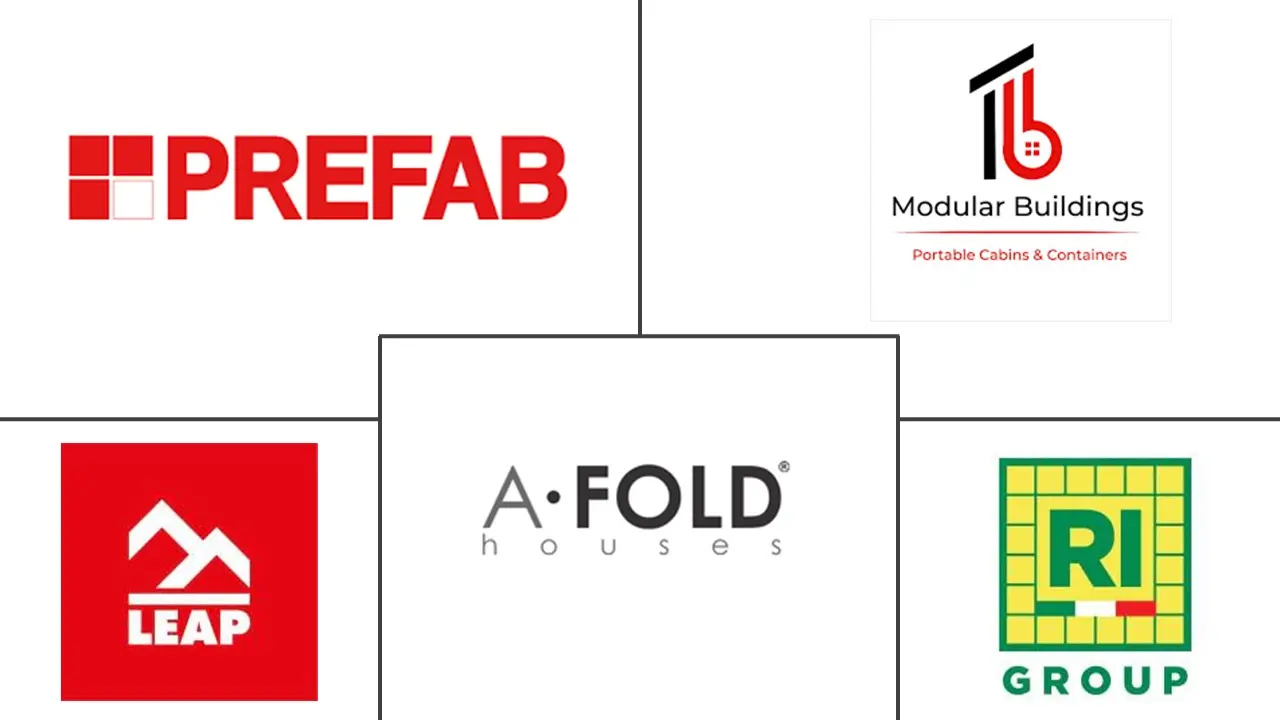Market Size of Italy Manufactured Homes Industry

| Study Period | 2020 - 2029 |
| Base Year For Estimation | 2023 |
| Forecast Data Period | 2024 - 2029 |
| Historical Data Period | 2020 - 2022 |
| CAGR | 5.00 % |
| Market Concentration | Low |
Major Players
*Disclaimer: Major Players sorted in no particular order |
Italy Manufactured Homes Market Analysis
The size of the Italy Manufactured Homes Market is USD 2.05 billion in the current year and is anticipated to register a CAGR of over 5% during the forecast period. The market is driven by the demand for luxury and spacious housing at affordable prices, along with the rising demand in urban areas of small towns for better living.
- People in Italy are increasingly turning toward prefabricated and modular houses as a less expensive and more sustainable option. The prefab home market in Italy is expanding. NIU Houses aims to provide a global response to architectural and construction processes and has designed a system to carry out house construction most efficiently and effectively.
- In Milan, the prime segment is gaining traction. Most new high-end real estate developments are emerging in urban areas outside the third circle (the road ring that roughly delimited the city's maximum urban extension until the end of WWII), contributing to the city's enlargement. To the west, there is Gambara-Bande Nere and Lorenteggio, with renewed interest in the locality of San Siro; to the south, Corso Lodi and Porta Vittoria; and to the east, Città Studi and Indipendenza-Viale Argonne. Due to new developments, the northern parts of NoLo (Nord di Loreto), Isola, and Bovisa continue to grow. The majority of Milan's modern and luxurious new developments are located in emerging areas outside the third circle due to greater comfort and space.
- The pandemic's shock has accelerated existing trends and introduced new dynamics in the real estate sector, such as the rationalization of offices due to the spread of teleworking and the search for larger homes, possibly with outdoor space. One of the most pressing issues has been the design, quality, and size of living spaces. The search for larger housing solutions has resulted in a greater emphasis on smaller towns, including those in metropolitan outskirts. The dynamics of properties transacted differed between major cities and smaller towns beginning in 2020, resulting in a slight shift in the number of properties transacted in favour of the latter.
- Modular construction differs from traditional construction because the structure is prefabricated in a factory. The structure is divided into sections to be installed in the designated area once completed. Because all fixtures, domestic appliances, and pavements are already installed, the assembled house or building is ready to use. The European prefab market is currently experiencing rapid expansion, and northern European countries are setting the pace for the continent. Italy is regarded as one of the emerging markets with rapid growth. The market for manufactured homes in Italy is expanding due to the efforts of skilled start-ups, such as Vicenza-based Mobu, which are highlighting this construction model.
Italy Manufactured Homes Industry Segmentation
Manufactured housing (MH) is a type of home that is built primarily or entirely off-site at a factory before being moved to a piece of land. The cost of construction per square foot for manufactured housing is typically much lower than for traditional on-site homes. The report covers the complete background analysis of the Italian manufactured homes market, including the assessment of the economy and contribution of sectors in the economy, market overview, market size estimation for key segments, and emerging trends in the market segments, market dynamics, and geographical trends, and COVID-19 impact.
The Italian manufactured homes market is segmented by type (single family and multi-family). The report offers market size and forecast values (USD billion) for all the above segments.
| By Type | |
| Single Family | |
| Multi-family |
Italy Manufactured Homes Market Size Summary
The Italian manufactured homes market is experiencing significant growth, driven by the increasing demand for affordable yet luxurious housing solutions. This trend is particularly evident in urban areas and smaller towns, where people are seeking more spacious and sustainable living options. The market is characterized by a shift towards prefabricated and modular homes, which offer cost-effective and environmentally friendly alternatives to traditional construction methods. Companies like NIU Houses and Mobu are at the forefront of this movement, leveraging advanced technology to meet the evolving needs of consumers. The pandemic has further accelerated these trends, as remote work and the desire for larger living spaces have prompted a reevaluation of housing preferences, with a notable shift towards metropolitan outskirts and smaller towns.
The market landscape in Italy is fragmented, with numerous local and regional players, alongside a few global entities, competing to capture market share. Key players such as RI Group, PREFAB SRL, and LEAPfactory SRL are actively engaging in partnerships and leveraging technological advancements to offer innovative housing solutions. The demand for manufactured homes is expected to create new opportunities for growth, particularly in emerging areas like Milan, where high-end real estate developments are on the rise. Despite challenges such as rising energy costs and high-interest rates, Italy remains an attractive destination for inward investment, supported by favorable government policies and a growing number of ultra-high-net-worth individuals. The market's expansion is also fueled by the appeal of Italy as a second-home destination, attracting international buyers seeking properties in desirable locations.
Italy Manufactured Homes Market Size - Table of Contents
-
1. MARKET INSIGHTS AND DYNAMICS
-
1.1 Current Market Scenario
-
1.2 Market Overview
-
1.3 Market Dynamics
-
1.3.1 Drivers
-
1.3.2 Restraints
-
1.3.3 Opportunities
-
-
1.4 Value Chain / Supply Chain Analysis
-
1.5 Porter's Five Forces Analysis
-
1.5.1 Threat of New Entrants
-
1.5.2 Bargaining Power of Buyers/Consumers
-
1.5.3 Bargaining Power of Suppliers
-
1.5.4 Threat of Substitute Products
-
1.5.5 Intensity of Competitive Rivalry
-
-
1.6 Government Initiatives and Regulatory Aspects
-
1.7 Impact of COVID-19 on the Market
-
-
2. MARKET SEGMENTATION
-
2.1 By Type
-
2.1.1 Single Family
-
2.1.2 Multi-family
-
-
Italy Manufactured Homes Market Size FAQs
What is the current Italy Manufactured Homes Market size?
The Italy Manufactured Homes Market is projected to register a CAGR of greater than 5% during the forecast period (2024-2029)
Who are the key players in Italy Manufactured Homes Market?
RI Group, PREFAB Srl, MB Modular Buildings, LEAPfactory srl and A-FOLD partners are the major companies operating in the Italy Manufactured Homes Market.

